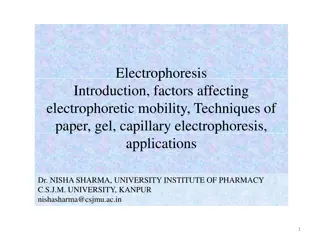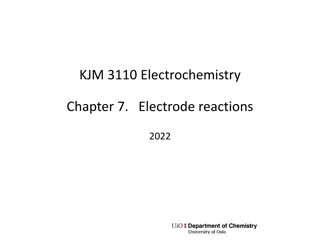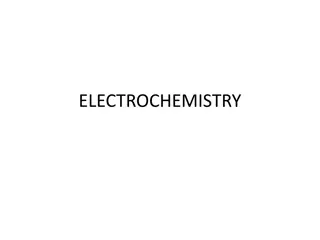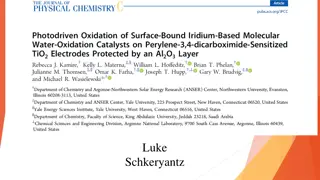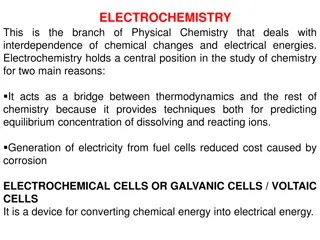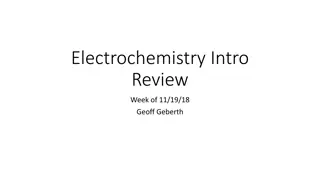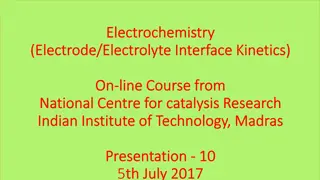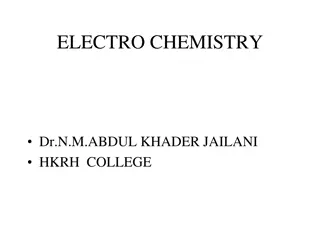
Advanced Electrochemical Techniques in Chemical Pathology
Learn about the advanced electrochemical techniques used in chemical pathology, such as potentiometry and coulometry, for accurate analysis of biological samples like chloride levels. Understand the principles and applications of electrochemistry in clinical analysis procedures. Gain insights into terminology and basic techniques in electrochemistry for precise measurement of electrical charge changes.
Download Presentation

Please find below an Image/Link to download the presentation.
The content on the website is provided AS IS for your information and personal use only. It may not be sold, licensed, or shared on other websites without obtaining consent from the author. If you encounter any issues during the download, it is possible that the publisher has removed the file from their server.
You are allowed to download the files provided on this website for personal or commercial use, subject to the condition that they are used lawfully. All files are the property of their respective owners.
The content on the website is provided AS IS for your information and personal use only. It may not be sold, licensed, or shared on other websites without obtaining consent from the author.
E N D
Presentation Transcript
Pakistan Society Of Chemical Pathologists Distance Learning Programme In Chemical Pathology (DLP-2) Lesson No 2 Electrochemistry By Brig Aamir Ijaz MCPS, FCPS, FRCP (Edin) Professor Of Pathology / Consultant Chemical Pathologist AFIP Rawalpindi 1
Q 1. You want to carry out chloride in biological samples by a very accurate method which records change in electrical charge. Which of the following technique is most suitable for this purpose: a. Amperometry b. Conductometry c. Coulometry d. Impedimetry e. Potentiometry c. Coulometry 2 16/04/2025 08:34
Electrochemistry Electrochemistry is the group of analytical techniques which uses the transfer of charge from an electrode to another phase, which can be a solid or a liquid sample. During this process chemical changes take place at the electrodes and the charge is conducted through the bulk of the sample phase. Both the electrode reactions and/or the charge transport can be modulated chemically and serve as the basis of the sensing process. 3
Clinical analysis procedures based on electrochemical sensors. 4
Basic Techniques in Electrochemistry Potentiometry Amperometry Coulometery Conductimetry 5
Q 2. In potentiometery the amount of current generated is: a. Exponential b. Logarithmic c. Negative d. Proportional e. Zero e. Zero 6 16/04/2025 08:34
Terminology (with some confusion) Electrode or sensor or cell is the basic device used in Electrochemistry. Electrodes comprises two or three sub-units called half cell or electrodes So term electrodes is used for whole cell and half-cell both (isnt it strange!!) In one electrode there are usually a reference electrode and an indicator electrode. 7
Potentiometry In potentiometric sensors, the potential difference between the reference electrode and the indicator electrode is measured without polarizing the electrochemical cell, that is, very small (almost zero) current is allowed. The reference electrode is required to provide a constant half-cell potential. The indicator electrode develops a variable potential depending on the activity or concentration of a specific analyte in solution. The change in potential is related to concentration in a logarithmic manner. 8
Amperometry Amperometry is a method of electrochemical analysis in which the signal of interest is a current that is linearly dependent upon the concentration of the analyte. As certain chemical species are oxidized or reduced (redox reactions) at inert metal electrodes, electrons are transferred from the analyte to the working electrode or to the analyte from the electrode. The direction of flow of electrons depends upon the properties of the analyte and can be controlled by the electric potential applied to the working electrode. 9
Coulometry Coulometry is an electrochemical technique, related to amperometry, where the amount of charge (coulombs) passing between two electrodes is measured. The amount of charge passing between the electrodes is directly proportional to oxidation or reduction of an electroactive substance at one of the electrodes. 10
Conductometry Conductometry (also called impedimetery) is based on the measurement of electrolyte conductivity, which varies when the cell is exposed to different environments. The sensing effect is based on the change of the number of mobile charge carriers in the electrolyte. If the electrodes are prevented from polarizing, the electrolyte shows ohmic behavior. Conductivity measurements are generally performed with AC supply. The conductivity is a linear function of the ion concentration; therefore, it can be used for sensor applications. 11
Q 3: Ion selective electrode is an example of: a. Conductometry b. Impedimetry c. Potentiometry d. Tonometry e. Voltametry c. Potentiometry 12 16/04/2025 08:34
Ion Selective Electrode (ISE) The ion-selective electrode (ISE) is a potentiometric sensor commonly used for the measurement of Electrolytes (e.g. H+, Na, K, Ca etc). The ISE usually comprises a membrane with a unique composition, either a solid (i.e., glass, inorganic crystal) or a plasticized polymer. The composition of ISE is chosen in order to impart a potential that is primarily associated with the ion of interest via a selective binding process at the membrane-electrolyte interface. 13
The schematic of: (a) liquid junction ISE, (b) solid- contact ISE. 14
Q 4: In an Ion-Selective Electrode the most important part determining the selectivity of the cell is : a. External reference electrode b. Inner electrolyte c. Internal reference electrode d. Membrane e. The frit d. Membrane 15 16/04/2025 08:34
Membrane in ISE Membrane is said to be at the Heart of ISE. Many technical innovations have lead to increased selectivity of membrane Types: Glass e.g.in H electrode PVC Inert Metal e.g. Platinum Active metal e.g. in Ag/Agcl 16
Q 5 : Which of the following is tested directly in the commonly used ABG analysers: a. Base Excess b. HCO3 c. PCO2 d. pH e. PO2 e. PO2 17 16/04/2025 08:34
Direct Analysis in ABGs Base Excess and HCO3 are calculated parameters Please note that techniques are available for direct HCO3 measurement in the form of Total CO2 by ISE but not in routine analysers. In the commonly used Severinghaus-style PCO2 sensor PCO2 is NOT measured directly. H+ are generated as CO2 reacts with H2O and these H+ are then measured . pH is negative log of H+ concentration and again an indirect measurement O2 is measured directly by amperometry 18
Q 6 : Electrochemical techniques are now available for the estimation of all of the following analytes EXCEPT: a. Arsenic b. Bicarbonate c. Heparin d. Osmolality e. Urea d. Osmolality 19 16/04/2025 08:34
Q 7 : By slight alteration in the composition, a glass electrode used for pH determination, can be designed for which of the following cations, with a fairly good selectivity: a. Calcium b. Lithium c. Magnesium d. Potassium e. Sodium e. Sodium 20 16/04/2025 08:34
Q 8 : Potassium-selective polyvinyl electrode extensively used these days incorporates which of the following ionophores in its structure: a. ETH b. Methylmonensin c. Noactin d. Tridodecylamine e. Valinomycin e. Valinomycin 21 16/04/2025 08:34
Q 9 : A useful modification in the classical Severinghaus-style PCO2 sensor is : a. Amperometric cell b. Differential potentiometric cell c. Haematocrit correction d. Use of ETH as ionophore e. Use of platinum coated membrane b. Differential potentiometric cell 22 16/04/2025 08:34
Q 10 : The sensors in which potentiometry is combined with an enzyme reaction were first used for which of the following analytes: a. Glucose b. pH c. PSA d. Sodium e. DNA a. Glucose 23 16/04/2025 08:34
Q 11: The usual function of grunge prowkers is to remove: a. Blings b. Grods. c. Grunges. d. Snarts. e. Trigs. Lesson Learnt: Students can pick the write answers without knowing anything So making MCQs is NOT an easy task !!! 24 16/04/2025 08:34
Q.12: You are Consultant Chemical Pathologist in a tertiary care hospital. Several firms have offered you to install ABG analysers on Reagent Rental Basis. You have to attend the meeting for selection of appropriate equipment. Your HOD has advised you to prepare the specification of the instrument and the calibration material before attending the meeting. Please write down the specification in the following sub-components against each heading. Please quote the reference you have followed for selection of these specifications: 25
a. H+ Electrode Electrochemical Principle used: Potentiometry Type of membrane: pH sensitive Glass membrane Internal Reference half cell: Ag/AgCl internal reference electrode in an internal solution of 0.1 M HCl. 26 Reference: IFCC Reference Methods for Measurement of pH, Gases and Electrolytes in Blood: Reference Materials) Eur. J. Clin. Chem. Clin. Biochem. 1991,253-61
H+ Electrode (Cont) External Reference half cell: Mercury electrode coated with Calomel (Hg2Cl2) External Reference solution: 20% KCl solution 27 Reference: IFCC Reference Methods for Measurement of pH, Gases and Electrolytes in Blood: Reference Materials) Eur. J. Clin. Chem. Clin. Biochem. 1991,253-61
b. Calibrating Buffers pH of Buffer for zero adjustment (Lower Calibrator) : Phosphate buffer of 7.392 pH at 37 C pH of Buffer for slope adjustment (High Calibrator) : Phosphate buffer of pH 6.839 at 37 C (Primary calibrator of NIST series or traceable to it) Please note that buffer of 7.392 pH contains less H+ as compared to buffer of pH 6.839 Secondly buffer of 7.392 pH is nearer to blood pH i.e. it is used for zero adjustment. 28 Reference: IFCC Reference Methods for Measurement of pH, Gases and Electrolytes in Blood: Reference Materials) Eur. J. Clin. Chem. Clin. Biochem. 1991,253-61
c. PO2 Electrode Electrochemical Principle used: Amperometry Type of Electrode: Amperometric electrode of Clarke type by applying -0.5- 0.600 V potential to electrode 29 Reference: Clinical Chemistry by 6th edition (2012).
PO2 Electrode (cont) Working Half Cell: Platinum electrode (as cathode) External Reference Electrode: Ag/AgCl reference electrode (as anode) Gas-Permeable Membrane: Polypropylene gas permeable membrane 30 Reference: Clinical Chemistry by 6th edition (2012).
d. General Specifications Type of Gas Calibrators (i.e. Cylinders or Solution): Solution calibrators are preferred as use of gas cylinder is a tedious procedure, requires skill and is difficult to maintain at laboratory level. 31
General Specifications (cont) With or without Electrolytes: With electrolytes as this can help serious cases in following ways e.g. Na, K, Cl help in determining anion gap and assessing exact type of acid base disorder specially triple disorders and diagnosis of underlying cause Ionized calcium helps in determining the biologically active calcium in blood Serum potassium measurement can also be used to assess cases of hyperkalaemia and hypokalaemia within shortest possible turnaround time to have speedy management of these serious emergencies 32
General Specifications (cont) Auto-calibration Intervals: According to CLIA 88 1 point calibration every 30 min or within 30 min of each measurement 2 point calibration every 8 h System calibration every 24 h Available Modes: Ready mode- this will be used in this tertiary care hospital to avoid any delay in reports as workload is high Stand by mode- not suitable in this big setup but can be used in lab with low or moderate work load to save reagents 33
General Specifications (cont) Any additional features: Co-oximetry- as it helps in diagnosis of cases of CO poisoning and methemoglobin and other disorders associated with Hb derivatives Hematocrit by co-oximetry specially in cardiac surgery patients Bilirubin(neonatal)- to determine severity of neonatal jaundice with capillary blood sample and short TAT Glucose and lactic acid by spectrophotometric technique can also be used to provide urgent information about cause of metabolic acidosis or in inborn error of metabolism or in cases of glycemic emergencies. 34
General Specifications (cont) Other specifications Instrument must require small sample volume (210 ul or less for full panel in micro sampling mode.) Low or no maintenance electrodes. Lengthy on board reagent stability and shelf life. Electronic QC submission with real time review. Short analysis time (results available within 140 seconds for full menu of tests) 35
Q 13. In a Quality Assurance meeting of Chemical Pathology Department PG Registrars have brought forward some problems. As a Consultant how will you find solution for them:
a. Dr Zuhra has noticed that the samples received from Bone Marrow Transplant Centres (the centre manages patients of haematological malignancies) have usually low PO2. Similar problems are uncommon from other wards located at even more distance from lab. Patient with haematological malignancies and very high leukocyte count have spurious hypoxemia (low pO2 in arterial blood sample but normal on pulse oximetry due to consumption of oxygen by activated leukocytes, called leukocyte larceny . In such cases pulse oximeter should be used to validate in vitro spurious hypoxemia.
b. Dr Attique, who had just joined the department as First Year Resident, observed that Result of Na+ in samples received from other hospitals for ABGs are very high when simultaneous electrolyte and ABG analyses are done in these samples. Check the anticoagulant used for ABGs. They are probably using syringes heparinised with Sodium Heparin as Na heparin will increase Na levels measured by approximately 3 mmol/L even when there is a correct proportion of heparin and blood. We must use Lithium heparin (LiHep) as anti-coagulant Since LiHep is not available we have to use syringes with lyophilized LiHep.
c. Dr Hadia has shown her concern regarding the results of haematocrit which is carried on ABG analysers. She says that instrument gives haematocrit on lower side. She has noted that this problem is more frequent in the samples from Cardiac Surgery and Obstetric wards. or PCV. . Use of conductivity to measure hematocrit in ABG analyzer can give hematocrit artifactually on lower side especially in cardiac surgery patients because of dilution of plasma protein by plasma lyte or hemodilution in obstetric cases or increase in plasma osmolality in other intensive care patients. So it is better to measure hematocrit by co-oximetry or direct measurement by microcentrifugation
d. Dr Najia narrated a particular incidence. A patient in operation theatre got a reaction to an anaesthetic agent (the details of which she did not know). His ABGs and electrolytes were done and conveyed to OT in shortest possible time but Consultant Anaesthetist was not happy with the results due to gross non-clinical correlation. The patient has developed malignant hyperthermia in response to suxamethonium or volatile anaesthetic agents. pH, Paco2, and Pao2 are all temperature dependent because gas solubilities are a function of temperature. When body temperature is higher than 37 C, the reported PaO2 and PaCO2 measured at 37 C will be lower than the actual values in the patient; the converse holds when body temperature is below 37 C, as may occur when cooling pt s body in this case. Clinicians are to be informed about lab policy of delivering uncorrected ABG report (at 370C) and they should demand temperature corrected report when required and also provide patient teperature at time of sample collection.
e. Dr Ammara has the QC Data of the instrument she is looking after. The QC results of pH are quite acceptable but those of PO2and PCO2 show unacceptable variations. Please note that the lab is using Aqueous QC material. Aqueous QC material has dissolved O2 and CO2 gases There can be several problems in use of these controls if proper precautions are not adopted e.g.: The gasses are usually in the upper part of the vial, so if these vials are opened without shaking some portion of the gasses may be lost. So vigorous shaking should be done before use. The temperature of the vials should be equilibrated at the temperature recommended by the manufacturer. Once opened they should be sampled as soon as possible avoid air mixing..
f. Dr Riaz, who is in-charge of a satellite lab, situated near your lab, told that he is attending the meeting to find solution of his problem. He said ABGs are analysed in his lab on a cartridge-based POCT analyser but often faces complaints from clinicians. Most frequent complaint is non- agreement of results from his instrument and those from the bench-top ABG analysers of your lab. On your inquiry he told that he uses 3 levels QC with satisfactory results. You have to guide him regarding the procedure to be adopted to find the fault. He should perform method comparison with bench top analyzer to find any significant bias. If bias is significant and more than allowable error, he should take all necessary steps to find the fault.


